




Philippines Trade Update: Trade trajectories trend along
 DOWNLOAD
DOWNLOAD

Policy Rate Updates: Double cut finale
 DOWNLOAD
DOWNLOAD

Monthly Economic Update: One for the road
 DOWNLOAD
DOWNLOAD


India rate decision rounds off wild week

An interest rate decision in India and Chinese trade figures are the main events for investors in Asia on Friday, rounding off a tumultuous week globally that saw an explosion of political volatility in the emerging world, heightened worries over US growth, and world stocks hitting new highs.
Asian markets go into Friday mostly on the front foot – the MSCI Asia ex-Japan index is up nearly 3% this week, the Hang Seng tech index is up almost 5% and, despite the political fireworks, Indian stocks are in the green.
Capital is flowing into emerging markets.
Japanese and Chinese stocks are struggling more, however. Expectations of tighter monetary policy and a stronger yen are capping the Nikkei, while economic gloom continues to weigh heavily on Chinese equities.
The Reserve Bank of India is widely expected to keep its key interest rate on hold at 6.50% on Friday, before cutting just once later in the year, probably in the fourth quarter, according to a Reuters poll.
With near-8% growth and above-trend inflation, there is little urgency for the RBI to begin cutting rates yet. Nor is there much incentive to move before the Fed, especially with the rupee languishing around record lows.
But with the Bank of Canada and European Central Bank lowering rates this week, following the Swiss National Bank, the global ‘higher for longer’ mantra may be losing its oomph.
US rates traders are now fully pricing in 50 basis points of easing from the Fed this year – one quarter-point cut likely coming in September, before the Presidential election, and two by the Dec. 17 to 18 policy meeting.
The 2-year US Treasury yield has now fallen six days in a row. That’s the longest uninterrupted decline going back to late last year, according to Tradeweb data, or back to March 2020, according to Reuters/Refinitiv indicative pricing.
The one G7 central bank going the other way is the Bank of Japan. Governor Kazuo Ueda said the central bank should reduce its huge bond purchases as it moves toward an exit from massive monetary stimulus, reinforcing his resolve to steadily scale back its nearly USD 5-trillion balance sheet.
The remarks keep alive expectations the central bank could embark on a full-fledged tapering of its bond-buying as early as its policy meeting next week.
But having driven yields higher this year, Japanese Government Bond bears have gone into retreat as global yields have fallen – the two-year and 10-year JGB yields have slipped every day this week.
China’s trade data, meanwhile, will be closely watched for signs that activity is picking up after months of disappointing numbers. Exports are seen rebounding strongly, rising 6.0% year-on-year, but import growth is expected to halve to 4.2%.
Here are key developments that could provide more direction to markets on Friday:
– India interest rate decision
– China trade (May)
– Japan household spending (April)
(Reporting by Jamie McGeever; Editing by Josie Kao)
This article originally appeared on reuters.com





 By Reuters
By Reuters